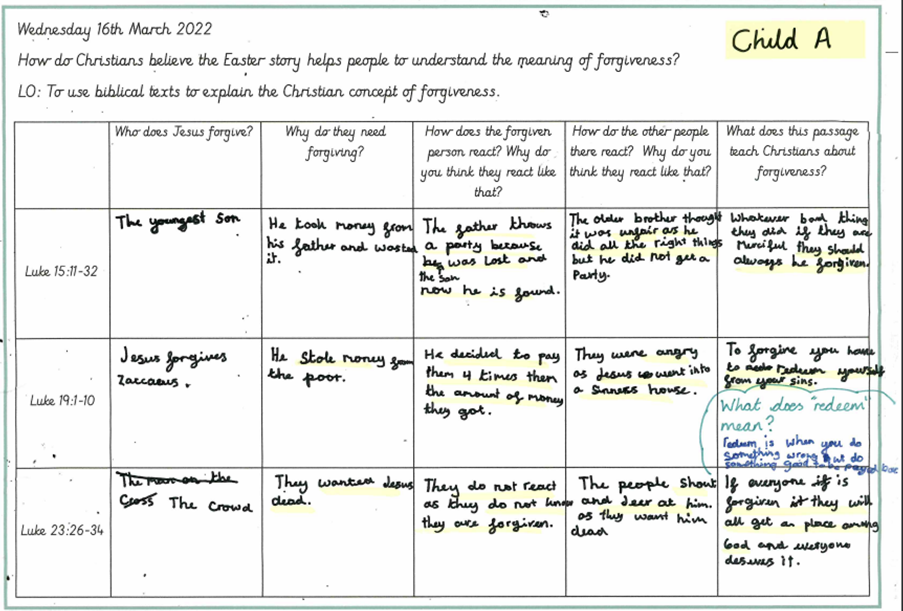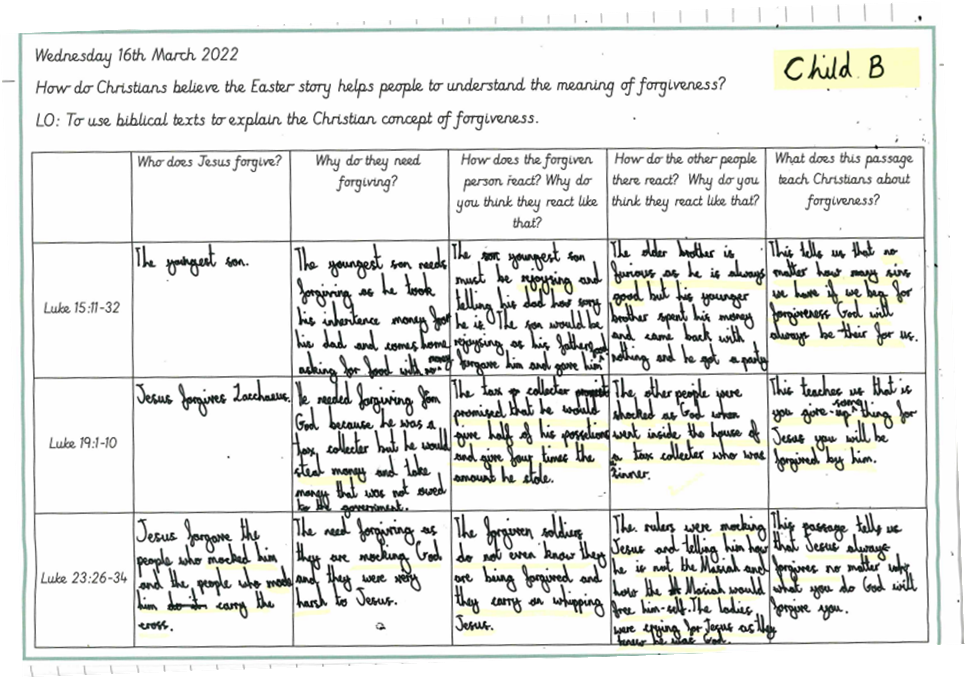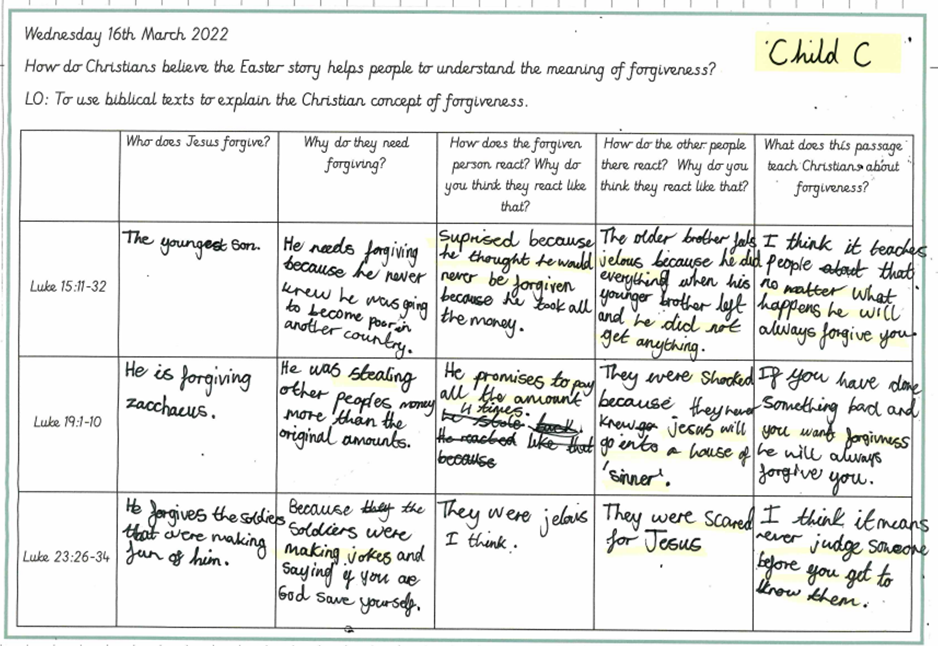
Group task – Examples of children’s work produced in the lesson featured in video 2
Here are three examples of children’s work from the video lesson. They represent a range of responses, from very strong to less so.
Bearing in mind the key question and learning objective for this lesson –
How do Christians believe the Easter story helps people to understand the meaning of forgiveness?
LI: To use biblical texts to explain the Christian concept of forgiveness?
– for each piece of work, consider these three questions:
- What are the strengths of this piece of work?
- Where has this child struggled?
- What would your next steps be for this child?
Discuss your answers, then compare them to the reflections from the class teacher.
Class teacher’s reflections
Child A
-
What are the strengths of this piece of work?
- The child has accurately picked out details from each text that help him to answer each question.
- For each text, the child has given a slightly different answer to ‘What does this passage teach Christians about forgiveness?’ This shows me that he is thinking deeply about that question and building his understanding of forgiveness from his analysis of the biblical text.
- He has accurately used some religious vocabulary, such as ‘sinners’ and ‘redeem’.
-
Where has this child struggled?
- He has misused the word ‘merciful’: in ‘if they are merciful they will be forgiven’, merciful should be repentant.
- You can see that he has struggled to work out who Jesus forgives in Luke 23:26-34 – he writes one answer, then changes it to another that is not completely correct. He has, however, understood that the people being forgiven do not realise this, but has not acknowledged the significance of this when explaining what this passage teaches about forgiveness.
- His answer to ‘How does the forgiven person react?’ for Luke 15:11-32 does not speak about the forgiven person, but the one who is forgiving. It is, however, an insightful comment about the father.
-
What would your next steps be for this child?
- This child shows a willingness to use religious vocabulary. This is to be encouraged and he now needs support to ensure he always uses these words accurately in context.
- Next time he does some biblical text analysis, he needs reminding to stay within the verses he has been given and look for insight there, particularly when the answers are not immediately obvious, rather than reading around the given passage – this will help him to find deeper insights than those he already has.
Example of children’s work completed in the lesson that is featured in video 2

Child B
-
What are the strengths of this piece of work?
- Child B’s answer to ‘How do the other people react?’ for Luke 19:1-10 was very insightful as it showed understanding that Jesus’ response was so shocking because he claimed to be God. The fact that he uses the term God is interesting as it indicates a possible understanding of Jesus showing his divinity by forgiving sins. His use of God in the final question for each text also shows his understanding that, for Christians, Jesus is considered to be God.
- Like Child A, he has offered different answers to ‘What does this passage teach Christians about forgiveness?’ for each of the passages. This shows that he is working hard to take his understanding of forgiveness directly from the Bible text and not from his own knowledge.
- When analysing Luke 23:36-34, Child B has thought in detail about all of the characters present in that passage and the following verses: the soldiers, the mockers in the crowd, and the women following Jesus. This shows that he is reading the text deeply and using what he reads to develop his understanding of forgiveness.
-
Where has this child struggled?
- This is a very strong piece of work that shows a secure understanding of how to use Biblical texts to deepen understanding of a Christian concept.
- There are some small grammatical issues with his use of religious vocabulary to pick up on, such as forgived.
-
What would your next steps be for this child?
- This child is ready to attempt more independent Biblical text analysis. The next lesson in the unit on Biblical text analysis focuses on the concept of hope (see sample work dated Monday 28 March 2022). This child is ready to access that without much teacher scaffolding or support.
Example of children’s work completed in the lesson that is featured in video 2

Child C
-
What are the strengths of this piece of work?
- For the first two texts, both of which have been analysed with support, Child C has successfully picked out the details from the biblical texts which answer the initial observation questions.
- She has shown some understanding of what these passages teach about the Christian concept of forgiveness – she has written ‘he will always forgive you’ twice.
-
Where has this child struggled?
- Overall, this response shows a simpler level of understanding of forgiveness but one that is still mostly rooted in the Biblical texts.
- Twice, she has written that ‘he’ forgives you and it is unclear who she means by this. This could be followed up with a conversation and an expectation to be more specific in responses next time.
- For the last two texts, both of which were done without teacher support, note that she has not offered a response to ‘why’ the forgiven person reacted as he did. For the third passage, she has struggled to unpick exactly who Jesus forgives and how they respond to being forgiven.
- When analysing the final text, she has lost sight of the concept of forgiveness and instead commented on jealousy and not judging people at first sight.
-
What would your next steps be for this child?
- Although Child C has mostly observed details from the texts correctly and worked out what is going on in each text, she has struggled to understand what the passages teach about forgiveness. As the scaffolding became less and she moved through each text, her difficulty with this became increasingly obvious. Next time, this child would require more teacher support to deepen her reading and find meaning in the text.
Example of children’s work completed in the lesson that is featured in video 2

